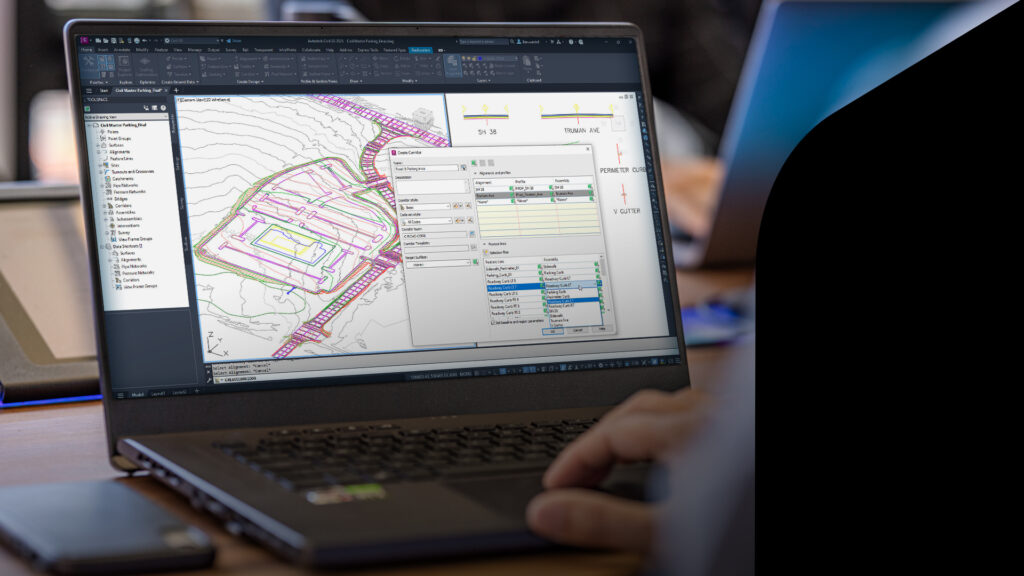
To help civil engineers and designers complete projects on time and within budget, tools such as Civil 3D, InfraWorks, and ReCap Pro can dramatically cut design times and improve model accuracy. Every year, Autodesk introduces new functionalities and updates to simplify the process more.
For the 2025 release of Civil 3D, InfraWorks, and ReCap Pro, we have focused on the things that you have been asking for. The goal is to make your life easier by cutting processing time, making them more intuitive and user friendly, and incorporating features that increase productivity and streamline workflows.
What’s new in Civil 3D 2025
Civil 3D has long been the design tool of choice for civil engineers. But complex projects with large design files can still take a lot of time to open, edit, and save. We have been working to make Civil 3D faster so that you can deliver your projects on time and within budget, especially for common and routine functions.
Workflows such as regenerating corridor models and editing pipe networks will take less time to process. Some processes that once took almost a minute, now execute in under 10 seconds. Working with surface files has also been significantly improved. The bottom line is you will notice a substantial boost in performance.
Updates for Civil 3D 2025 include:
Coordinate system modernization
To help civil engineers set up coordinate systems fast and efficiently, we’ve improved the UI, making it more intuitive and easier to use. Civil 3D 2025 will also allow you to set NAVD 88 vertical datum (not just horizontal data) and import customer-requested coordinate systems. We’ve added more coordinate systems to the database. These changes can help improve productivity, ease-of-use, and design accuracy.
Multi-baseline corridor setup
With this improvement, designers don’t have to wade through the “pick and click” process when setting up a corridor model that has multiple baselines. With a single click, they can now set up these elements in one go. The UI has also been significantly updated to facilitate this time-saving update.
MMS file saving
Any time a large DWG surface file is created in a Civil 3D project, an MMS file is also created. MMS files can get very large. In some cases, these files can be several gigabytes in size. In the past, the MMS file was saved anytime the surface DWG file was opened and closed—even if no surface changes were made. This took additional time and processing power unnecessarily. Now, MMS files are only saved when the surface is modified. This one change will reduce Autodesk Construction Cloud (ACC) file processing time dramatically.
Esri ArcGIS® basemaps
We have expanded our strategic alliance with Esri to include new integrations in the Civil 2025 release. To help designers and engineers visualize terrain, streets, and structures, we’ve added five Esri basemaps to the Civil 3D ribbon under the Geolocation tab:
- Open streets
- Esri streets
- High-resolution satellite and aerial imagery
- Light and dark grey monochrome maps
For more detailed information, please see the Civil 3D release notes for technical documentation.
What’s new for InfraWorks 2025

For InfraWorks 2025, we’ve made some important enhancements when it comes to workflows for bridges and tunnels. They include:
Improved portal visualization and terrain removal capabilities
Starting with the 2025 edition, designers can create tunnel portals. Gone are the days of using generic objects to represent portals. Designers will also be able to remove terrain layers with a single click instead of one at a time.
Elimination of cruciform joints
We’ve also enhanced the algorithm that rotates tapered tunnel rings to follow ground alignment and avoid the formation of cruciform joints. For 2025, we’ve redesigned the algorithm to reduce risks, errors, and rework.
Improved collaborative workflow
This improvement will be felt by everyone working in InfraWorks with elements designed in either Inventor or Revit. The change has to do with how design elements are stored using file path names. Before, if a designer updated a bridge deck or girder, for example, that change was available only to the designer who made the change. Now paths are consistent and will be accessible for teams working with parametric content stored in Autodesk Docs.
Line girder tendon improvements
Designers and engineers can now develop and work with tendons that are not already in the InfraWorks tendons library. They can import then into ASBD (Autodesk Structural Bridge Design) for a refined girder analysis.
Changing with Revit bored rings now possible
You can now create Revit bored rings in Revit instead of relying solely on ones created in Inventor. The advantage is that Revit-created rings become part of the library and can be manipulated in InfraWorks. During the documentation phase in Revit those rings originally authored in Revit remain editable. This helps save time for minor edits at the end of the design workflow.
For more detailed information, please see the InfraWorks release notes for technical documentation.
What’s new in ReCap Pro 2025
For ReCap Pro 2025, we’ve enhanced Scan2Design workflows by adding additional feature extraction capabilities. In the past, extracting 3D features such as ADA ramp and driveway geometry from large point clouds has been a time-intensive manual exercise.
Now, these linear features can be automatically extracted using a template to identify and extract these features automatically with about 95% accuracy. You can then import these extracted geometries into other tools, such as Civil 3D, InfraWorks, and Revit.
Another new feature in ReCap Pro includes being able to import colored scan data from Faro Focus premium scans. For more detailed information, please see the ReCap Pro release notes for technical documentation.
Community resources
We love to hear from you, so we can address your feedback or new ideas. Tell us what you think and what you need, what works well and what could be addressed next in our product forums:
See the new updates in action
Sign up for our upcoming webinars to see firsthand how these new capabilities can be applied to your civil infrastructure projects:
Register for April 9th What’s New in Civil Infrastructure Part 1
Register for April 23rd What’s New in Civil Infrastructure Part 2
Get Started
Take the next step closer to experiencing these features first-hand—if not, what are you waiting for? Get started with the Autodesk Access application on your desktop. And if you’re not yet a subscriber, be sure to check out free trials of Civil 3D, InfraWorks, and ReCap Pro.
